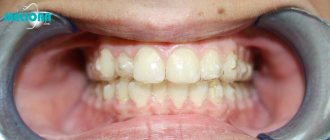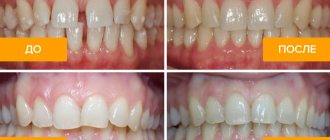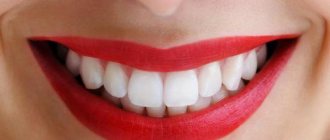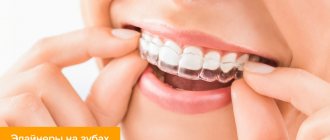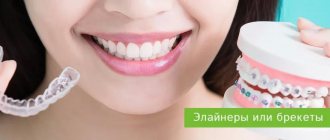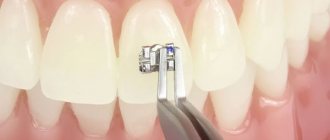The selection and installation of aligners and self-ligating braces is carried out in the Implantmaster clinic using modern equipment, under the guidance of orthodontists with extensive experience, in comfortable conditions, at an affordable price.
The problem of curvature of teeth, their improper closure and other dental anomalies cause a lot of negative experiences for people. Installing braces comes to the rescue, but not everyone decides to do this, due to the aesthetic imperfections of such orthodontic devices and the discomfort when wearing them.
Fortunately, today a new device has been developed to cope with aesthetic defects in the oral cavity - aligners. These are advanced orthodontic appliances made of clear plastic. They are characterized by increased wearing comfort, are quite easily removed from the mouth and do not require special care rules. However, the key advantage of aligners is aesthetic perfection - they are practically invisible on the teeth even during close communication with others.
Next, we will talk about the pros and cons of braces and aligners in more detail. You will also learn about the cost of the above orthodontic devices in modern dental clinics.
At Implantmaster dentistry, the installation of aligners and braces is performed by specialists with impressive professional experience. In this case, advanced diagnostic methods are used, and dental impressions are created in digital format. This greatly simplifies orthodontic treatment, improves its quality and comfort, and also guarantees extreme precision in the production of orthodontic appliances.
Orthodontic treatment and basic devices
As you know, orthodontists are involved in identifying, eliminating and preventing dental anomalies. In their opinion, regardless of the patient’s age, there is always the opportunity to move the tooth to the right place, as well as to stimulate or inhibit the development of the bone structures on which the teeth are attached. This is due to the compliance of the supporting-retaining apparatus.
There are several ways to perform orthodontic treatment, namely:
- Conservative therapy. It consists of using special devices: braces, transparent aligners, thin overlays on teeth, etc.;
- Surgical intervention. This method is used in difficult situations when it is not possible to eliminate the defect using orthodontic appliances. However, a prerequisite after surgery is the use of braces or transparent aligners.
To understand what is better to choose after surgery - aligners or braces - you should pay attention to the following criteria.
Intimate disadvantage of all braces
We specifically highlighted this minus as a separate item. Doctors are tactfully silent about this drawback of any brace systems, including lingual braces. But it exists. And it causes a lot of problems for those with braces. This is an injury, but not to the tongue, but to injury by parts of the braces to the mucous membrane of the sexual partner during intimate caresses: causing micro-scratches with possible infection of the wounds due to insufficient hygiene of the braces.
Such statistics are periodically published in the European and American press, where they really and openly talk about it. With veneers and aligners, this problem is absent or minimized: we always try to clean our teeth normally, but with braces it becomes more and more difficult to clean.
How are aligners made - invisible aligners for teeth?
To make aligners, the doctor at the clinic takes impressions of the patient’s jaws and sends them to the manufacturer of the aligners - to us, to the Star Smile company. Using a 3D scanner, a digital model of the teeth is obtained. The trajectory of the teeth is calculated and the required number of aligners is determined - from five to several dozen aligners. It all depends on the severity of the primary pathology.
The video shows how the digital jaw rotates, some lines appear along which the teeth line up. And soon this digital model will begin to come to life in the aligners. Star Smile has developed a unique software simulation of dental biomechanics. You see on the screen how all the lines are aligned, how the patient’s gums precisely move along with the teeth on the screen. This is very important - after all, future aligners should not cause any inconvenience and should fit perfectly on the patient, that is, unnoticed, producing the maximum effect of correcting the bite.
Next stage
— an order for future aligners is sent for 3D printing. Work on the production of aligners is carried out using 3D printers. As a result of digital 3D printing, accurate models of the patient’s teeth are obtained. Models of blanks for aligners are made step by step, that is, already in the dynamics of future treatment; for each stage, a different set of teeth is made.
Next stage
— a vacuum former comes into operation for the production of aligners. Blanks are placed on a special vacuum former mold - prototypes of future aligners. Thanks to super high-tech plastic, these blanks are light, transparent and will be invisible on the teeth.
Next stage
— the aligners acquire their exact geometry and are completely tailored to the anatomical features of the patient’s teeth and gums.
Finish stage
— packaging of manufactured aligners. All aligners are placed in individual sterile bags, listed according to the period of their wearing, and the patient’s name. The aligners have already acquired their own individuality.
All that remains is to put all the individual packages in the Star Smile branded box and the order is sent to your treating orthodontist at your dentistry.
How orthodontists install aligners
And so your aligners came to the doctor. In this video, orthodontist Alexey Trezubov talks in detail about the installation of aligners and shows how the aligners are installed and worn:
What is more comfortable - aligners or braces?
Bracket systems have a complex structure. Most often, they are represented by locks that are attached to the surface of the teeth, a special wire that connects the locks to each other, and, most often, tiny devices necessary to fix the arch in the groove. All of the above components allow you to create a traction force, which helps change the position of the teeth in the row. The cause of discomfort after fixing braces is their bulky design. It can have an irritating effect on the mucous membrane, especially if such a device is installed on the inside of the jaw.
Today there is a better alternative to braces – aligners. We are talking about orthodontic devices made of plastic and characterized by increased wearing comfort due to the absence of sharp elements. They are easily removed from the mouth for the purpose of cleaning, eating and performing at any social events. Simply put, clear aligners do not force a person to give up their usual lifestyle. But, even if you decide to use aligners instead of braces, you should remember that to achieve the maximum therapeutic effect, they should be worn at least 22 hours a day. This means that it is advisable to remove them from the mouth in exceptional cases - for hygiene purposes and for the purpose of eating food. However, such self-monitoring can negatively affect the treatment, since patients often lose aligners and delay their re-installation.
What is more expensive
Installing aligners instead of braces is more expensive, especially with long-term treatment in several stages. But with a correct comparison, the difference is not so significant.
The price of the cap depends on the brand. Domestic - Star Smile is cheaper than foreign Invisalign. The cost of braces is affected by the brand and type of construction and material. The most affordable metal models. Systems made of ceramics and sapphire are more expensive. Lingual devices are expensive, their cost is higher than vestibular devices.
Any braces are purchased for one time, without taking into account the time of wearing. If the teeth are positioned correctly on one jaw, a structure must also be installed on it. Braces cannot be placed on one row of teeth.
With aligners, everything is different. The treatment is simulated step by step using a computer program. The doctor immediately sees how many caps are needed in a particular case. The longer the correction period, the more plates will be required. The final price also depends on this. But if one row of teeth does not need correction, the number of trays is reduced, since the patient needs to undergo fewer stages of treatment.
Aesthetic characteristics of aligners and braces
The aesthetic criterion is fundamental when implementing orthodontic treatment. In the production of aligners, special transparent plastic is used, which ensures almost impeccable aesthetics. According to the manufacturers, even with close communication, others will not understand that you have transparent aligners installed.
Trying to independently understand the difference between braces and aligners, many focus on this indicator – the visibility of the structure on the teeth. However, today you can find devices that are highly aesthetic, for example, sapphire or ceramic braces. In this case, the shade of the locks adapts to the natural tone of the enamel, and the wire is made of transparent material. Moreover, lingual models of braces have now been developed, which are fixed on the inside of the jaw. This makes them almost invisible even during close dialogue with others.
Manufacturing and installation of bite correction systems
| Manufacturing and installation | ALINERS | BRACKETS | VENEERS |
| Preparation time | 7 days | 1-2 days standard | from 7 days to 30 |
| Installation time | from 45 minutes to 1 hour both jaws | 3-6 hours | each jaw 6-8 hours |
| The need to take impressions before installation | intra-oral scanning + impressions (optional) | Yes | Yes |
| The need to use anesthesia | No | No | Yes |
Any production of bite correction systems implies the patient’s obligation to make impressions
. Of course, with the help of a doctor. The procedure itself is inconvenient, but it must be done. Aligners are preferred here, since aligners are already digital, computer technologies, and intraoral scanners can be used in their work: the doctor ran such a scanner over the patient’s teeth, and the computer showed their appearance. All of your both jaws on the computer screen are as if they were alive. There is no need to take dental impressions. But, it’s true, not many clinics yet have such advanced technologies. Therefore, the advantage of aligners here is not particularly strong. Therefore, let's also compare the manufacturing and installation times of bite correction systems.
The fastest braces to make. The slowest ones are veneers.
Veneers or braces
? Standard braces are made for you within 1-2 days. The longest in production are veneers. This is understandable. In fact, each dental plate is sharpened for each of your teeth. Therefore, veneers can take up to 30 days. Aligners confidently hold second place - the standard production time is up to 7 days maximum.
The fastest to install are aligners.
Over time of installation
Braces take longer to install than aligners; it can take you up to 6 hours. Aligners are the easiest and fastest way: installation on both jaws will take a maximum of 1 hour. But with veneers you will have to suffer - since each jaw is glued from 6 to 8 hours.
Cost of treatment with aligners
Now you have the opportunity to get a beautiful smile at a cost:
- for the simplest case of correction with aligners from 4,000 rubles
per month - in the most difficult case of teeth straightening with aligners - less than 10,000 rubles
per month
In reality, Star Smile today has the lowest prices
in Russia for aligners compared to all aligner manufacturers! (Invisalign, Orthosnap, 3D Smile)
Find out all prices for aligners
Cost of treatment with aligners:
Star Smile also has the best prices for treatment with aligners in Russia, which covers more than 100 cities of the Russian Federation, since the company’s main goal is to make prices for aligners affordable for the vast majority of patients. You can see this for yourself - look at the prices for aligners.
Our team of doctors
Maxillofacial surgeon, Implantologist
Bocharov Maxim Viktorovich
Experience: 11 years
Dental surgeon, Implantologist
Chernov Dmitry Anatolievich
Experience: 29 years
Orthopedist, Neuromuscular dentist
Stepanov Andrey Vasilievich
Experience: 22 years
Endodontist, Therapist
Skalet Yana Alexandrovna
Experience: 22 years
Orthopedic dentist
Tsoi Sergey Konstantinovich
Experience: 19 years
Dentist-orthodontist
Enikeeva Anna Stanislavovna
Experience: 3 years
Which aligners should you choose?
The aligners do not differ significantly from each other either in material, structure, or functions. Different companies have different software, which is critical in simulating treatment and making trays. Among other things, doctors at the manufacturing laboratory play an important role, as they are directly involved in treatment planning. The cost and the mechanism for calculating it also depend on the manufacturing company: in some cases, each mouth guard has a fixed cost and the final price is proportional to their quantity, in others, money is taken for the entire treatment, no matter how many mouth guards it includes, or for certain packages. In any case, depending on the clinic and laboratory, the price of treatment may vary significantly !
Main manufacturing companies:
- Invisalign (USA) is a leading company and accounts for the largest share of the global aligner market. The most expensive, but at the same time thoughtful and effective system.
- AirAlign (Italy) - somewhat cheaper than American aligners.
- Starsmile (Russia)
- VSD (Russia)
- 3D smile (Russia)
- Orthosnap (Russia)
- Many others (new laboratories appear every year).
On the other hand, I would not recommend that you delve too deeply into the differences between aligners from different companies. The most important thing is to find a good doctor who has knowledge and experience in this field. In this case (if the treatment results have been demonstrated to you and you are satisfied with them), you should rely on the experience of the orthodontist . A small correction: if an orthodontist treats exclusively with aligners, then he will probably have a lot of experience, but, in this case, it is inevitable to go beyond the indications for treatment and use this method in situations in which braces would bring a much faster, predictable and a high-quality result (and there are many such situations; they are determined by the design of the mouthguard itself and do not depend on the doctor’s experience). Therefore, even if you want to be treated by such a specialist, I strongly recommend that you go for a consultation with a good orthodontist who practices both methods of treatment, and if he gives the go-ahead for treatment with aligners, then you can safely go for treatment to the first doctor.
Are aligners more effective than braces?
When the question arises about what to choose – braces or aligners, it is important to pay attention to the effectiveness of their use. Despite the fact that orthodontic appliances made of transparent material can achieve the desired result, their effectiveness has not been proven in certain situations. For example, in cases where corpus movement of teeth is required, the use of braces is considered more appropriate. When using clear aligners, this process may take longer. However, if we are talking about malocclusion pathology, in which the overlap between the upper and lower teeth is impaired, the need for using aligners is justified.
When trying to decide on a choice between aligners or braces, you should pay attention to the obvious advantages of the latter. These orthodontic devices allow you to correct even the most complex defects, unlike transparent aligners. But you should remember the nuances of specific braces models. For example, ceramic and sapphire devices are more fragile and susceptible to breakage. In turn, lingual systems demonstrate better results in the fight against deep bites.
In any case, the difference between braces and aligners is obvious: classic orthodontic devices cope with severe pathologies, while improved transparent aligners are designed to eliminate only minor deficiencies.
What are the advantages of aligners?
Many of the benefits have been mentioned above. In general, they work on much the same principle as braces. By applying constant pressure to incorrectly positioned teeth, mouth guards move them in the desired direction. At the same time, the bone tissue is absorbed in the right places, firmly fixing the teeth and preventing them from returning.
One of the main advantages of aligners is their aesthetics. For many people this criterion is key. They are very thin and transparent. Almost invisible on the teeth, even up close. Convenience of treatment is another plus in the collection of overhead mouth guards. They are almost not felt in the mouth, unlike braces. Also, you don’t need to get used to them for a long time, and they also have a very soft effect due to the ideal smoothness of the surface. The tongue, mucous and bone tissues are not injured.
The material from which the aligners are made is completely compatible with the tissues of the human body. It is hygienic and hypoallergenic. In the case of braces, allergic reactions are rare, but they do occur.
Braces are much more difficult to maintain than aligners. To clean them, you do not need to buy a special brush or brush. You can get by with your usual toothpaste and brush. The only peculiarity is that teeth and aligners need to be cared for separately.
For aligners, the prognosis and result are calculated by a computer, which produces an accurate result. Even during preparation, the patient understands what he will receive in the end - how many pairs of aligners and how often they will need to be changed, as well as how long the treatment will last.
Adaptation to aligners and braces
The problem of getting used to orthodontic devices is considered one of the most serious for modern patients. In this case, the question is: “Aligners or braces, which is better?” - disappears on its own. Of course, transparent devices are advantageous in terms of adaptation, since they can be periodically removed from the oral cavity. In addition, such mouthguards are made of elastic and soft materials, which eliminates massive pressure on the teeth.
As for braces, they are fixed once and for a long period of time. Consequently, the process of getting used to them is more difficult and longer. This is also due to the complex design features of traditional devices. They are represented by many elastic bands, hooks, locks, wires and other additional elements, compared to soft and smooth aligners.
Braces
These are rather complex non-removable orthodontic structures that are designed to correct the position of teeth and correct the bite. They consist of clasps of various types, which the dentist attaches to the outer or inner surface of the tooth using special glue, and arches of various thicknesses and shapes, which create the necessary pressure on the dentition. The entire system together allows you to move teeth within a row and around their axis to ultimately create an even and beautiful smile.
The brace system dates back to the invention of the orthodontic arch at the dawn of the twentieth century by Edward Engle, a talented dentist who not only classified the types of bite problems, but also came up with ways to solve them. Braces have come a long way - from the complex and bulky metal installations that you might see on teenagers in American films, to small, elegant designs made from various materials that can be individually chosen. So, today the range of braces includes not only the familiar silver metal options, but also transparent ceramic and even colored braces, which make the long treatment process a little more fun and are more popular with children.
Reception write with aligners and braces
Since it is not possible to remove the braces before eating, the patient must adhere to a strict diet: solid foods must be crushed, and during the correction it is necessary to exclude the intake of seeds and nuts. When it comes to using aesthetic devices, all dishes with food dyes are excluded from the diet.
In the case of using transparent aligners, there are no restrictions on removing the structures while eating food. The main rule is to brush your teeth before fixing the aligners again.
Review of treatment with aligners
Patient M., during treatment. The attending orthodontist is Olga Nikolaevna Plink.
- How old are you? — I am 27 years old, I started treatment at 26.
— Do you work with people? — I work in a large team, work meetings, meetings, constant contact with people.
— Why did you decide to be treated with mouth guards? — For me, the determining factor in choosing a treatment method was aesthetics; it was important for me that the design would not be conspicuous. After the doctor assured me that treatment with aligners and braces would give the same result, I preferred the aligners, since they are almost invisible on the teeth, and can also be removed for meals.
— How long did your treatment take? — At the moment, my treatment lasts about 9 months, there is still about the same amount of time ahead.
— Have you experienced any discomfort or pain while wearing a mouth guard? — There is a slight discomfort on the first day of wearing a new mouthguard, but judging by the reviews of friends, this does not even compare with the discomfort from wearing braces. I was recommended to wear a new mouthguard at night, this time is enough to get used to it and in the morning I feel almost no pain.
— Was it difficult for you to care for your aligners? — Caring for the aligners does not involve any difficulties; after each removal they need to be rinsed well. A special container is included for storage. After eating, before putting on the mouth guards, you need to brush your teeth or rinse your mouth well. I recommend purchasing an irrigator, since during the treatment the teeth move and gaps are formed in which food debris can get stuck, the irrigator copes with this problem.
— Would you recommend treatment with mouth guards to other patients? — I highly recommend treatment with mouthguards to everyone for whom it is indicated. The only negative is the relatively high cost of treatment compared to braces, but it is worth it. I am very glad that I chose the aligners and can’t wait to finish the treatment to see the results.
Caring for braces and aligners
If you still haven’t decided what to prefer, aligners or braces, and considering their pros and cons, pay attention to the simple rules of care in relation to transparent aligners. Experts recommend removing them from the mouth after each meal, rinsing thoroughly with water and cleaning with a brush. They have a polished surface that is not prone to deposits. In turn, due to the absence of sharp elements, it is possible to prevent the accumulation of food particles. However, there is one undesirable point - the high probability of plastic staining when drinking coffee and tea.
As for traditional braces, they are much more difficult to clean. Particles of solid food may accumulate under the arch and in the area of the locks, which indicates the need to use special brushes, brushes and dental floss. In the absence of proper hygiene, deposits can provoke the appearance of carious lesions.
Aligners vs braces: what's the difference?
Aligners and braces are orthodontic devices for correcting bites that affect teeth according to a similar principle. Both systems place precise pressure on pathologically located teeth, forcing the units to shift, rotate, and take the correct position in the bite. To change the force and pressure point:
- braces are reinforced with an orthodontic arch - the orthodontist periodically changes the metal wire, causing the teeth to move more or less;
- Patients change aligners every two weeks - each subsequent device continues the correction according to a pre-calculated program.
The similarity of impact is the only thing that unites the two orthodontic systems. And although it is believed that aligners are an analogue of braces, this is not entirely true.
Bracket systems: characteristics, types, advantages
Braces are a complex multi-component orthodontic structure. It includes:
- plates with clasps - attached to the teeth with special dental glue;
- orthodontic metal arch - connects the plates of braces and is responsible for correcting the bite and moving the teeth;
- ligatures are an element of ligature braces necessary for attaching the arch to the plates.
The first braces were metal - unaesthetic and bulky. Nowadays, braces are made from different materials. In pediatric dentistry, braces are placed:
- metal - valued for the effectiveness of correction, low cost, and speed of treatment;
- ceramic - white or made to match the color of the patient’s tooth enamel, hardly noticeable on the teeth, fragile, requiring long-term wearing to achieve treatment results;
- sapphire - similar to ceramics, but transparent, which makes the system visible on the teeth only upon very close examination.
A separate group is metal lingual braces. They are placed on the inner surface of the teeth. This design is completely invisible, but has some disadvantages - high cost, inconvenience of wearing braces, long adaptation.
All braces (except lingual) are somehow noticeable on the teeth, which is their main disadvantage. Also among the general disadvantages of the orthodontic system it is worth noting:
- long-term adaptation, getting used to a foreign object in the mouth;
- non-removable design - only an orthodontist can remove or change anything in the device;
- food restrictions - when wearing braces, the patient is prohibited from consuming hard and viscous foods that can cause breakage or deformation of the structure;
- complex multi-stage care - braces are cleaned using several brushes, an irrigator, and brushes.
But despite all the shortcomings, braces have distinct and undeniable advantages:
- efficiency - metal braces are suitable for eliminating all malocclusions and pathologies and invariably demonstrate excellent results of orthodontic treatment;
- speed of correction - a rigid braces system puts strong pressure on the teeth, which significantly speeds up treatment;
- variety of prices - the choice of materials and designs allows you to select braces for any financial opportunity.
The disadvantages of braces often include the frequency of visits to the orthodontist. But this is a controversial issue, since the number of monthly appointments depends on what type of brace system the patient wears. When choosing ligature braces with elastic bands, the child comes to the doctor for an appointment 2 times a month - to replace the elastic elements. If the correction is carried out with self-ligating braces, in which the arch is fixed in special locks, and there are no elastic bands, then the frequency of visits is once a month.
Aligners: pros and cons of correction
Aligners are removable transparent products that are fixed separately on the patient’s upper and lower jaws. They are made of hypoallergenic polymer and perfectly duplicate the shape of each tooth. Due to their small thickness, transparency and tight fit, the aligners are completely invisible on the teeth.
To correct the bite, the orthodontist models on the computer the step-by-step correction of the anomaly - he calculates each step of the treatment. The patient observes in visualization how the bite changes as the aligners are changed. After creating a model and preparing a treatment plan, the orthodontist takes impressions of the patient’s teeth and sends an order to the dental laboratory for the production of orthodontic appliances.
To correct the position of the teeth, the patient is given a set of aligners that must be worn consistently, changing every two weeks. The duration of daily wearing is at least 22 hours.
The design solution and method of correction determine the advantages and disadvantages of the aligners. Among the advantages:
- invisibility on the teeth - the transparent polymer adheres tightly to the enamel, is not conspicuous, and is not noticeable in photographs;
- lack of adaptation - patients get used to the aligners quickly;
- preservation of the usual quality of life - there is no need to give up your favorite foods and drinks;
- clear result - 3D modeling allows you to see changes and evaluate improvements in occlusion;
- Easy care - the products are easy to clean and wash with warm water.
Among the disadvantages:
- the need for a responsible approach - if the patient forgets to wear the aligners for the prescribed time or change them in a timely manner, there will not be a good treatment result;
- mandatory brushing of teeth after meals - putting aligners on dirty teeth is strictly prohibited;
- mandatory removal of aligners from teeth when drinking drinks - you can only drink water with aligners on your teeth, otherwise the liquid will stain the polymer or get between the device and the enamel, unsightly changing the color of your teeth;
- average effectiveness - aligners have a gentle effect and are not always able to cope with the pathology being corrected;
- cost - in most cases, aligners are more expensive than braces, especially when compared with metal braces.
For a long time, the disadvantage of aligners was that they were placed only on adults. Now there is no such restriction. Dental equipment is improving, and today teenagers can choose between aligners or braces.
What is cheaper – braces or aligners?
Consultation with an orthodontist
- X-ray panoramic image
- Oral examination
- Drawing up a treatment plan with costs
Price : 2,000 ₽
*if treatment continues in the clinic according to the plan, the consultation is not paid
| Self-ligating metal braces Damon Q | from 250,000 ₽ |
| Self-ligating ceramic braces Damon Clear | from 250,000 ₽ |
| Aligners - trays for straightening teeth | from 350,000 ₽ |
If you are wondering what to prefer - aligners or braces - price is not always the main selection criterion. In some cases, the cost of treatment with standard orthodontic systems and transparent aligners can be the same. For example, if we are talking about the use of sapphire or ceramic bracket systems, the prices for them are considered identical to aligners. Ligature devices made of metal are considered more affordable in cost.
There are differences in payment procedures:
- A set of transparent trays necessary for the complete correction process is manufactured at a time. After this, they are transferred to the patient. The need to visit a specialist is present only once every two months - for consultation.
- If you use traditional braces, at each return visit to the orthodontist you will need to pay an additional fee for replacing certain elements.
In turn, a negative point when treating with transparent aligners is the increased likelihood of damage or loss. Sometimes there is a need to replace them - in case of significant cracks or a noticeable change in shade. Braces are also susceptible to fractures. Often, carious lesions may appear under such devices, which requires additional treatment costs.
In Implantmaster dentistry, the cost of installing transparent aligners has a lower limit of 350 thousand rubles. When fixing ceramic or metal braces in our clinic, you will have to pay from 250 thousand rubles.
In what cases are braces used?
Since braces are a permanent structure, they are installed on adults and children over 10-12 years old, that is, when the dental system has already been formed. Until this point, orthodontists advise correcting teeth using lightweight removable structures - plates or trainers. They are quite enough to have an impact on mobile children’s teeth.
Installation of braces is necessary to solve significant problems of an already developed jaw. Thus, they show their effectiveness in cases of severe crowding and rotation of individual teeth relative to their axis. Braces slowly but surely create the correct position of the dentition and secure the teeth in new places through prolonged wear. On average, the structure is installed for 1.5-2 years. It is difficult to talk about the timing of treatment, because much depends on the physiological characteristics of a particular patient. The cost of braces includes the price of the elements themselves, their installation, as well as visits to the dentist and is calculated individually during the treatment process.
From an aesthetic point of view, braces are unsightly: they are visible and protrude. And at first they cause discomfort to the patient: they rub their cheeks, lips, and it’s uncomfortable to eat in them. It is not so easy to maintain oral hygiene with braces; food gets clogged, you need to use special threads, brushes and an irrigator.
It is not recommended to eat very solid foods, because... you can simply “bite” the braces. These difficulties fade into the background when the first changes become noticeable, and over time, patients get used to both these features and the braces themselves and stop noticing them.
Orthodontist Kozhevnikova N.I.
Obvious pros and cons of aligners and braces
If you are faced with a choice between braces or aligners, and want to find out the orthodontist’s opinion on this issue, experts do not recommend focusing on cost. The fact is that the inflated price of transparent mouth guards is made up for by the numerous advantages of their use. This is an aesthetic component, increased wearing comfort, and the absence of dietary restrictions.
If you have any doubts about the treatment method, consult our experienced specialists. We will perform a study of the dentofacial system using modern X-ray and orthopantomogram methods, carefully examine its condition and select an orthodontic device option that will best cope with the aesthetic problem. Implantmaster specialists also provide services in the field of creating digital impressions using the latest 3Shape Trios scanner, carry out 3D modeling of each stage of treatment in three-dimensional format with visual animation of the transformation process, make impressions, fix a suitable orthodontic device and give recommendations regarding its further care .
Author:
Aligners
Aligners are a new direction in dentistry, which appeared as a result of the development of innovative technologies and are also intended to correct dental defects. Essentially, this is a system that allows you to predict changes in occlusion under several scenarios using 3D visualization. Even before the start of treatment, the orthodontist can simulate the result and demonstrate it on the monitor.
The appearance of the aligners is transparent aligners. They are made from a dental impression. For the full course of treatment, a set of caps is prepared. The plates change sequentially, which allows you to gradually move the teeth into the desired position along the trajectory planned by the doctor. The mouthguards are invisible in the mouth and do not interfere with articulation. To achieve the desired effect, you need to wear the aligners for at least 18 hours every day. The products are optimally suited for the treatment of defects of mild to moderate complexity.
Dentists at the PROPRICUS clinic place 2 types of mouth guards:
- Invisalign is the #1 aligner in the world. The products are durable and clear, manufactured in the USA to fit the shape of the patient's teeth. Recommended not only for adults, but also for children over 7 years old. Delivery time for the finished kit is 2-4 weeks.
- Star Smile are Russian-made devices with a lower cost. The total amount depends on the number of plates in the set. Quickly produced and delivered to the patient.
Aligners are an analogue of braces, since they correct the dental apparatus according to the same principle. There are differences in properties and functions.
Who are they suitable for?
Transparent plates have many advantages, so this treatment method is suitable for everyone. High-quality correction is guaranteed provided that it is worn regularly. If parents are not sure that their child will constantly wear the plate, you can purchase a device with a marker. This model allows you to monitor a teenager when he is left unattended and determine whether the child wore the device for the required time or not. Transparent mouth guards are also recommended for public people whose work is related to television, show business, etc.
Advantages
Aligners have a number of advantages:
- They are practically invisible in the mouth, which is important for patients who do not want to demonstrate to others the fact of orthodontic treatment.
- Small and thin - they are comfortable to wear.
- Comfortable to use - easy to remove, do not injure soft tissues, do not interfere with diction.
- Provides quick adaptation.
- There are no problems with care - just wash the aligners regularly in soapy water.
- There are no dietary restrictions.
The plates are effective and work delicately with minimal discomfort to the individual. The treatment speed is faster.
What can be corrected with aligners?
Any dental defect can be treated with Invisalign aligners. The plates eliminate diastemas and tremata, crooked teeth, deep, open, mesial and crossbites. Uneven teeth are effectively corrected for children when baby teeth have not been completely replaced by molars. Invisalign aligners are made from a soft biopolymer composition. The material is safe for humans, does not stain under the influence of organic dyes, does not cause irritation and does not injure soft tissues.
BEST BRACKETS IN ORTHODONTIC PRACTICE
In my practice, I use only premium orthodontic braces - self-ligating braces. These braces are the latest generation of orthodontic equipment that is as comfortable and safe as possible for children and adults, and the treatment time with its use is 25-30% faster than when using ligature braces of an outdated design.
Self-ligating braces are the No. 1 orthodontic equipment in the best clinics in the USA, a country with the highest level of orthodontic treatment.
Read my great article on self-ligating braces. In it you will find a lot of up-to-date information about this technology, the cost of the course, many photographs before and after treatment using this equipment for straightening teeth.
Follow the link: SELF-LIGING BRACKETS - LATEST GENERATION BRACKETS FOR UNMATCHED ORTHODONTIC TREATMENT RESULTS.
Duration of treatment
The duration of treatment depends on the complexity of the specific clinical case. You should come for an appointment every four to six weeks. During some periods of treatment, the interval between visits can be increased without compromising the quality of treatment, since for a given type of equipment the schedule for visiting the orthodontist can be individual.
And the best part is that many people around you may simply not notice that you are wearing something, so we can safely say that everyone will notice the changes in your smile, and not the treatment process. Therefore, aligners are the best analogue of braces.
Watch the video: “What alternative does braces have?”

